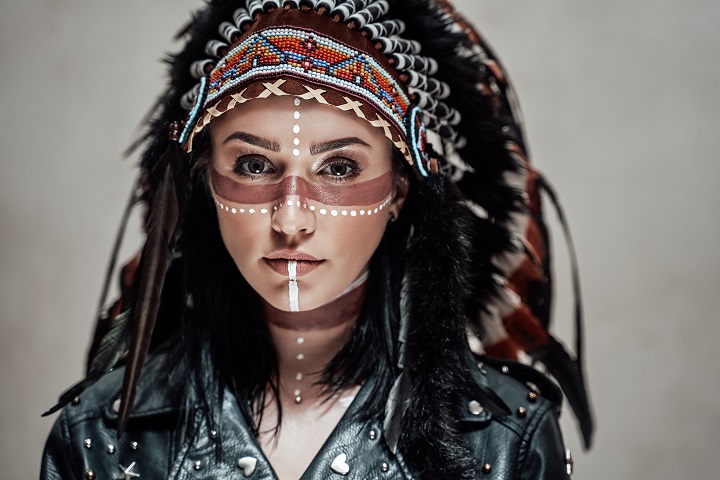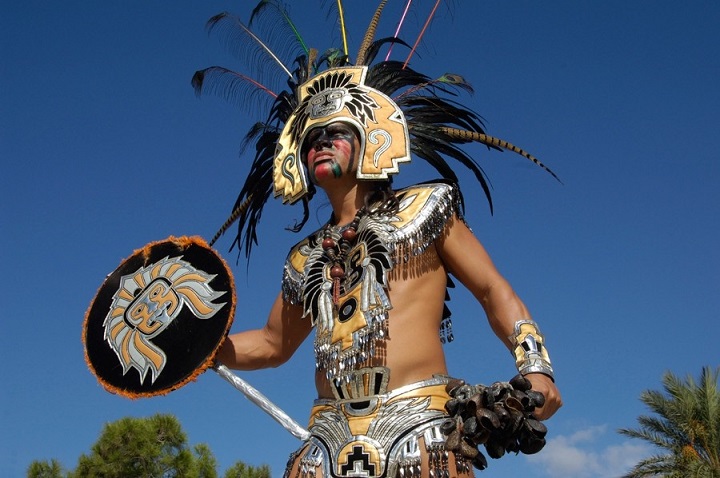The Aztecs were a nomadic tribe believed to have begun as a tribe of hunters and gatherers.
Their name came from their homeland Aztlan which loosely translates to “white land.”
The Aztecs were mainly nomads who historians believe arrived in Mesoamerica around the 13th century.
The tribe was also known as the Tenochca, from which the name of their capital Tenochtitlan emerged, or the Mexica (the name of the city that would replace Tenochtitlan and the name of the entire country).
From their magnificent capital city, the Aztecs emerged as one of the most dominant forces in central Mexico.
They developed an intricate political, social, commercial, and religious system that brought most of the region’s city-states under their control during the 15th century.
That was until the Spanish, led by conquistador Hernán Cortés overthrew the Aztec empire in 1521 and captured Tenochtitlan, bringing an unfortunate end to Mesoamerica’s last great native civilization.
It is believed that about 240,000 people, including Aztec nobles, died in the city’s conquest.
After securing his victory, Cortés razed the city to the ground and built Mexico City on its ruins.
Mexico City would soon become the premier European center of the New World.
One of the things we can borrow from the Aztec tribe is the intricate native American hairstyles they wore.
Table Of Contents
Symbolism of Aztec Hairstyles
According to most Native tribes, hair is closely tied to one’s spiritual life energy; therefore, some hairstyles took a symbolic meaning.
Aztecs used hairstyle to show a person’s status in society, precisely what tribe they belonged to. Hairstyles were a sign of conquer and battle victory among Aztec warriors.
A warrior could shave off the rest of the hair and leave a tuft hanging over the right ear, and another would wear their hair into a stylish mohawk. Hairstyles were also a sign of a person’s occupation.
For instance, priests generally vow never to shave their hair and instead allow it to grow long before getting matted. On the other hand, the Aztec women wore their hair loose but braided it on special occasions.
Upper-class women would braid their hair into beautiful intricate patterns and decorate it with ribbons and ornaments on special occasions.
Traditional Mexican haircuts are still prevalent to date. However, most Mexican men and women have shaken off tradition and experimented with different hairdos like braids.
Here’s the thing, though; cultural braids today are all about cultural appropriation, and braids, as it is, aren’t cultural appropriation. Traditional Mexican braids, for instance, don’t include pop smoke braids, box braids and cornrows.
Most Represented Ways Aztecs Wore Their Hair
The Aztecs had a wide range of hairdos that different people wore. Children, women, and men wore different hairstyles to signify their ranks and status in society.
Women Aztec Hairstyles
Aztec women wore their hair in different ways. For instance, loose hair was common among young unmarried women. Married women would mostly braid or bind their hair around the head. Married women wore their hair in a typical style throughout Nahua towns and cities.
The women would sport two protruding hair twists at the crown of their heads. The style was made by separating two long hair strands, twisting them, and bringing the two tips to rest on top of the head while the rest rested at the neck’s base.
Noble women had a variety of hairstyles. For instance, some noble women wore their hair loose and shoulder length while others braided it and added ornaments. Others arranged it in horn-like plaits and crossed the ends over their foreheads.
Men Aztec Hairstyles
If you were not a warrior, priest, constable, master of youths or royalty, you were considered a commoner, and there was a specific hairstyle for such men.
Commoners wore their hair neck-length and included a fringe. It’s one of the best hairstyles for men with straight hair if you consider sporting it today.
Children Aztec Hairstyles
Until age ten, young Aztec boys shaved their heads while the girls were allowed to grow their hair long. According to the Codex Mendoza, long hair symbolized a woman’s unmarried status.
After the age of ten, young male children were allowed to graduate to the next phase, allowing a patch of hair at the back to grow. The only way the teenager could cut off the tuft and wear the hairstyle of an Aztec warrior was by capturing an enemy in battle.
Older boys who were yet to cut the tuft at the back of their heads faced endless teasing from the other boys and, worse, girls.
Hairstyles Among Different Professions and Ranks
Aztecs had intricate hairstyles to symbolize different ranks and professionals.
They include the following:
Warriors and Royals Hairstyles
While most commoners similarly wore their hair, Aztec warriors distinguished their ranks using elaborate hairstyles and ornaments. Many warrior hairstyles had significant meanings. Some signified that one was yet to take a captive in war.
Quachic Warrior
The Quachic warrior hairstyle was referred to as the ‘Quachichictli’ and comprised of a stiff fringe growing down the center of a shaved scalp.
Tequihua Warrior
All warriors aspired to wear the Tequihua warrior hairstyle, also worn by the merchant deity Yacatecuhtli. The hairstyle consisted of the frontal section of the hair pulled up into a columnar shape.
Tlacatecatl Lord
A Tlacatecatl Lord had a unique “Quetzallalpiloni” headdress or ornaments given in tribute from the rich cities and provinces. Those that wore the headdress were part of the imperial family.
Otomí Warrior
The Otomí warriors were known to be ferocious, hence the name, and to be a part of it meant you were part of a somewhat particular order like that of the Jaguar and Eagle warriors.
Otomí warriors wore their hair in a unique manner where the topknot was tied with a red band while the rest of the hair was worn longer than that of Tequihua warriors. Their earplugs and lip ornaments were also unique but weren’t made of gold.
Priests
Aztec priests wore their hair long and untended. Young nobles who entered religious schools allowed their hair to grow and only cut it when they departed. Those who became priests, however, let their hair grow untouched forever.
A priest’s hair was usually tied back with a white ribbon and smeared with soot like the rest of the body. The locks became matted, moldy and long and were likened to “tightly curled horse’s manes.”
After so many years, like hair extensions for men, the braids would grow so long that they would reach the knee in length. The priests’ hair arrangements symbolized their roles in the religious setup.
The loss of the specific physical detail would therefore affect the possibility of one completing his duties. Punishment was common for priests who would either be banished, killed, or have the hair above their foreheads cut as a symbol of humiliation.
Constables
Aztec constables were the official executors who carried out death sentences at the command of the emperors. Their hairstyles were distinctive, and they also dressed in a specific manner.
They were distinguished by their black body paint and black or brown faces, plain cloaks, and tubular earplugs. Their hair grew long with white or red ribbons twisted around the hair and fasted at the neck.
Their duties included hitting people over the head, strangling them with cords, cutting them to pieces or stoning them publicly.
Master of Youths
The master of youths wore unique hairstyles whose aesthetic arrangements lay in the shaving of the temples. They would run a sharpened turtle shell piece along the temple to shave off the hair.
Their attire or cape also distinguished them and was usually made of rough fiber. The master of youth was allowed to wear unique ornaments to differentiate his standing in society from the commoners. He would wear a unique necklace made from shells and feathers.
Tools Used for Aztec Hairstyles
The kind of tools Aztecs used depended mainly on the hairstyle. Men’s ponytail styles, like those worn by novice and Otomí warriors, were tied on top with a white ribbon. Priests tied their hair at the back using a white ribbon and smeared soot on it.
Constables, the official executioners, tied their hair using white and red ribbons. Aztecs used other tools, like turtle shells, to shave off the hair. Some young women used hair dyes to color their hair.
How Did Aztecs Style and Maintain Their Hair
Priests didn’t have to maintain their hair as it was long and unattended. Women maintained their hair by adding accessories and braiding it appropriately. Warriors would keep their hair as they moved from one stage to another.
For instance, novice warriors would cut the tuft of hair at the back once they captured an enemy at war. Another way of maintaining hair involved dying, as some young unmarried women did.
Modern Adaptations of Aztec Hairstyles
Traditional Aztec hairstyles have found their way into the modern grooming world. Braided styles, for instance, are still prevalent today and women continue experimenting with different hairdos.
Mexican women today sport:
- Short cuts – Traditionally, Aztec women wore their hair long, but today, women have taken the lopping off the locks as a political statement against set gender norms.
- Colored strands – Mexican women are known for their lush and dark strands, but some women have embraced color and chosen to go lighter.
- Loose and straight strands – Modern women have found a way to let their strands fly free.
As for the men, some Aztec warrior hairdos have been adopted by some men in modern times. All kinds of male hairstyles, like the classic man bun, have been inspired by Aztec warriors’ hairstyles of the day.
FAQ
Did the Aztecs wear braids?
Braided styles were common among Aztec people. A prominent spirituality-based braided style was the scalp rock, where a warrior’s head was shaved and a tuft of hair remained on the crown of his head.
However, traditional Aztec braids didn’t include certain styles like cornrows and box braids.
Did the Aztecs have dreadlocks?
Dreadlock styles were rare among the Aztecs.
What were the beauty standards of the Aztec empire like?
The beauty standards of the Aztec empire were relatively high and cleanliness was emphasized, especially when it came to a woman’s hair. Painting their bodies and hair was considered attractive.
How did the Aztecs keep their hair clean?
The Aztecs kept their hair clean, especially the women, as cleanliness was paramount.
How did Aztec hairstyles differ from those worn by other cultures?
The Aztecs cut their hair in various styles depending on one’s rank in society.
Jay is one of the members of the Beardoholic writers team and NFL, celebrity barber. As a master barber with years of experience, Jay can make your beard look any way you envision. Jay’s specialty is black men’s hair and beard styles, but he also has deep knowledge on how to create a perfect neck and cheek line, short or long beard and virtually any beard and hair shape and style.



